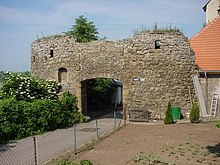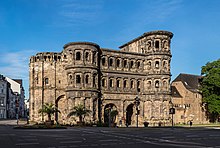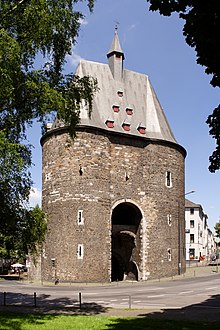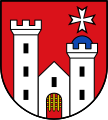A fortified gateway is an element of a variety of fortified structures, such as a castle or walled town.[1] Fortified gates or gateways appear in the Bronze Age and reach into the modern times.[2]
City gate[edit]
Gatehouse[edit]
Torburg[edit]

In German, a "Torburg", lit. "gate castle", is a relatively autonomous and heavily fortified gateway of a castle or town. Medieval castle gateways of this type usually have additional fortifications in front of them. A common form is the tower gateway (German: Turmtorburg); a variant is the bastion gateway (German: Halbrundturmtorburg). They are common in Europe.
Examples in Europe[edit]
France[edit]
Germany[edit]



- Deutsches Tor in Metz
- Ehrentor, Eigelsteintorburg, Hahnentorburg, Kuniberts Tower, Schaafentor and Severin Gate in Cologne
- Town fortifications of Erkelenz
- Friedländer Tor in Neubrandenburg
- Marching Gate and Bridge Gate in Aachen as well as Aachen's city walls
- Upper Gate in Neuss
- Fortified gateway of Seeburg Palace
- Star Gate in Bonn
- Fortified gateway of Stolberg Castle in Stolberg (Rhineland)
- Porta Alba, Porta Nigra and Imperial Baths in Trier
Romania (Transylvania)[edit]
- Stundturm in Sighișoara
United Kingdom[edit]
- Westgate at Canterbury
- Balkerne Gate at Colchester
- Bargate, Southampton
- Castle Upton in Templepatrick, Northern Ireland
- Kingsgate and Westgate, Winchester
- Monnow Bridge, Monmouth - the only surviving type in Britain with the gatehouse positioned on the bridge
- Portgate on Hadrian's Wall
- Five Arches Gate and Whitesand Gate at Tenby
- Micklegate Bar and other gates at York
On coats of arms[edit]
-
Fortified gate in the Limerick coat of arms
-
Fortified gate in the Dinslaken coat of arms
-
Fortified gate in the Königswinter coat of arms
-
Fortified gate in the Wiehl coat of arms
See also[edit]
References[edit]
- ^ "Definition of". www.merriam-webster.com. 2024-03-16. Retrieved 2024-03-21.
- ^ "Israel: 5,500-year-old gate dating back to early bronze age, discovered!". The Times of India. ISSN 0971-8257. Retrieved 2024-03-21.




Well, that’s interesting to know that Psilotum nudum are known as whisk ferns. Psilotum nudum is the commoner species of the two. While the P. flaccidum is a rare species and is found in the tropical islands. Both the species are usually epiphytic in habit and grow upon tree ferns. These species may also be terrestrial and grow in humus or in the crevices of the rocks.
View the detailed Guide of Psilotum nudum: Detailed Study Of Psilotum Nudum (Whisk Fern), Classification, Anatomy, Reproduction